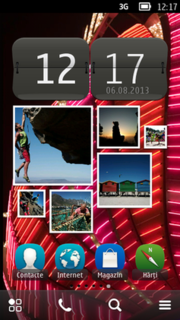Symbian^3
 |
|
|
Home Screen of Nokia Belle Feature Pack 2 (Last version of Symbian)
|
|
| Developer | Accenture on behalf of Nokia (historically Symbian Ltd. and Symbian Foundation) |
|---|---|
| Written in | C++ |
| OS family | RTOS |
| Working state | Discontinued, Open Source |
| Source model | Closed source, previously open source |
| Initial release | June 5, 1997 (as EPOC32) |
| Latest release | Nokia Belle Feature Pack 2 / 2 October 2012 |
| Available in | Multi-lingual |
| Update method | 65 |
| Package manager | Nokia Store, .sis, .sisx, .jad, .jar |
| Platforms | ARM, x86 |
| Kernel type | Real Time Microkernel, EKA2 |
| Default user interface | S60 (from 2009)estab |
| License | Proprietary, previously licensed under EPL |
| Official website |
symbian |
Symbian is a discontinued mobile operating system (OS) and computing platform designed for smartphones. Symbian was originally developed as a closed-source OS for PDAs in 1998 by Symbian Ltd. Symbian OS was a descendant of Psion's EPOC, and runs exclusively on ARM processors, although an unreleased x86 port existed. Symbian was used by many major mobile phone brands, like Samsung, Motorola, Sony Ericsson, and above all by Nokia. As a pioneer that established the smartphone industry, it was the most popular smartphone OS on a worldwide average until the end of 2010 – at a time when smartphones were in limited use, when it was overtaken by Android, as Google and its partners achieved wide adoption.
Symbian OS was (from 2001) essentially a shell system and required an additional user interface (as middleware) to form a complete operating system. Symbian OS became prominent from the S60 (formerly Series 60) platform built by Nokia, first released in 2002 and powering most Nokia smartphones. Symbian eventually became the most widely used smart mobile operating system. UIQ was another Symbian user interface mostly used by Motorola and Sony Ericsson, whereas in Japan there was also the MOAP platform. Applications of these interfaces were not compatible with each other, despite each being built atop Symbian OS. Nokia was the majority shareholder in Symbian Ltd. and purchased the entire share in 2008. The non-profit Symbian Foundation was then created to make a royalty-free successor to Symbian OS - seeking to unify the platform, S60 became the Foundation's favoured UI and UIQ stopped development. Symbian^1 (or S60 5th Edition) was created as a result in 2009. Symbian^2 was only used by carrier NTT DoCoMo, one of the members of the Foundation, for the Japanese market. Symbian^3 was released as in 2010, by which time it became fully open source. Symbian^3 received the Anna and Belle updates in 2011.
...
Wikipedia

